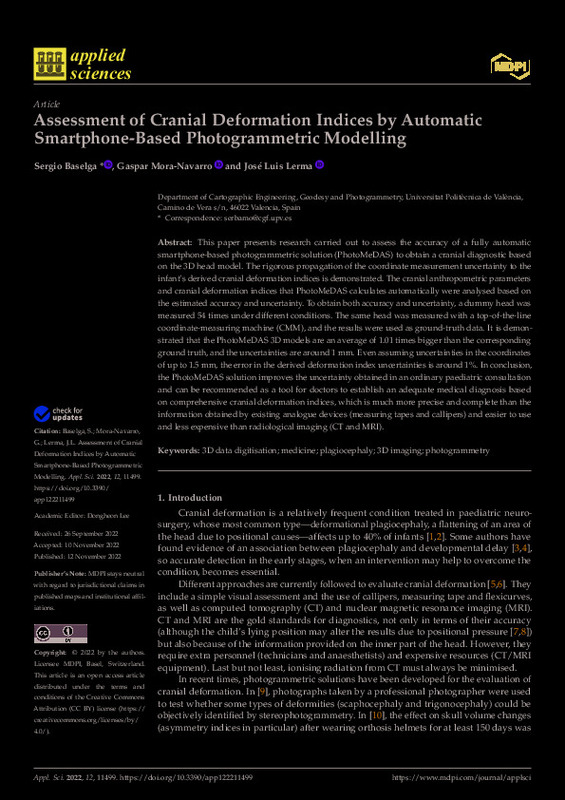JavaScript is disabled for your browser. Some features of this site may not work without it.
Buscar en RiuNet
Listar
Mi cuenta
Estadísticas
Ayuda RiuNet
Admin. UPV
Assessment of Cranial Deformation Indices by Automatic Smartphone-Based Photogrammetric Modelling
Mostrar el registro sencillo del ítem
Ficheros en el ítem
| dc.contributor.author | Baselga Moreno, Sergio
|
es_ES |
| dc.contributor.author | Mora Navarro, Joaquin Gaspar
|
es_ES |
| dc.contributor.author | Lerma, José Luis
|
es_ES |
| dc.date.accessioned | 2023-05-22T18:02:02Z | |
| dc.date.available | 2023-05-22T18:02:02Z | |
| dc.date.issued | 2022-11 | es_ES |
| dc.identifier.uri | http://hdl.handle.net/10251/193498 | |
| dc.description.abstract | [EN] This paper presents research carried out to assess the accuracy of a fully automatic smartphone-based photogrammetric solution (PhotoMeDAS) to obtain a cranial diagnostic based on the 3D head model. The rigorous propagation of the coordinate measurement uncertainty to the infant's derived cranial deformation indices is demonstrated. The cranial anthropometric parameters and cranial deformation indices that PhotoMeDAS calculates automatically were analysed based on the estimated accuracy and uncertainty. To obtain both accuracy and uncertainty, a dummy head was measured 54 times under different conditions. The same head was measured with a top-of-the-line coordinate-measuring machine (CMM), and the results were used as ground-truth data. It is demonstrated that the PhotoMeDAS 3D models are an average of 1.01 times bigger than the corresponding ground truth, and the uncertainties are around 1 mm. Even assuming uncertainties in the coordinates of up to 1.5 mm, the error in the derived deformation index uncertainties is around 1%. In conclusion, the PhotoMeDAS solution improves the uncertainty obtained in an ordinary paediatric consultation and can be recommended as a tool for doctors to establish an adequate medical diagnosis based on comprehensive cranial deformation indices, which is much more precise and complete than the information obtained by existing analogue devices (measuring tapes and callipers) and easier to use and less expensive than radiological imaging (CT and MRI). | es_ES |
| dc.language | Inglés | es_ES |
| dc.publisher | MDPI AG | es_ES |
| dc.relation.ispartof | Applied Sciences | es_ES |
| dc.rights | Reconocimiento (by) | es_ES |
| dc.subject | 3D data digitisation | es_ES |
| dc.subject | Medicine | es_ES |
| dc.subject | Plagiocephaly | es_ES |
| dc.subject | 3D imaging | es_ES |
| dc.subject | Photogrammetry | es_ES |
| dc.subject.classification | INGENIERIA CARTOGRAFICA, GEODESIA Y FOTOGRAMETRIA | es_ES |
| dc.title | Assessment of Cranial Deformation Indices by Automatic Smartphone-Based Photogrammetric Modelling | es_ES |
| dc.type | Artículo | es_ES |
| dc.identifier.doi | 10.3390/app122211499 | es_ES |
| dc.rights.accessRights | Abierto | es_ES |
| dc.contributor.affiliation | Universitat Politècnica de València. Escuela Técnica Superior de Ingeniería Geodésica, Cartográfica y Topográfica - Escola Tècnica Superior d'Enginyeria Geodèsica, Cartogràfica i Topogràfica | es_ES |
| dc.description.bibliographicCitation | Baselga Moreno, S.; Mora Navarro, JG.; Lerma, JL. (2022). Assessment of Cranial Deformation Indices by Automatic Smartphone-Based Photogrammetric Modelling. Applied Sciences. 12(22):1-15. https://doi.org/10.3390/app122211499 | es_ES |
| dc.description.accrualMethod | S | es_ES |
| dc.relation.publisherversion | https://doi.org/10.3390/app122211499 | es_ES |
| dc.description.upvformatpinicio | 1 | es_ES |
| dc.description.upvformatpfin | 15 | es_ES |
| dc.type.version | info:eu-repo/semantics/publishedVersion | es_ES |
| dc.description.volume | 12 | es_ES |
| dc.description.issue | 22 | es_ES |
| dc.identifier.eissn | 2076-3417 | es_ES |
| dc.relation.pasarela | S\486761 | es_ES |








